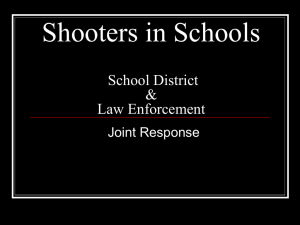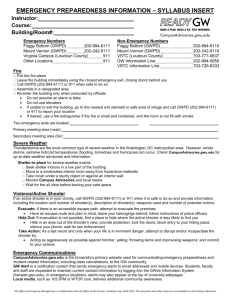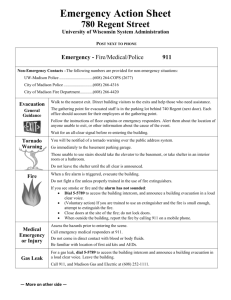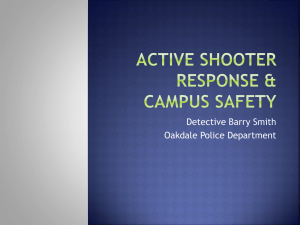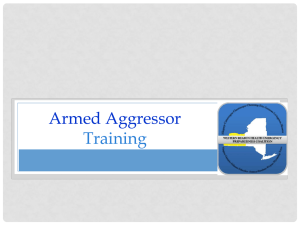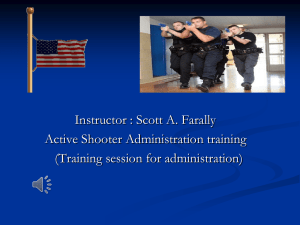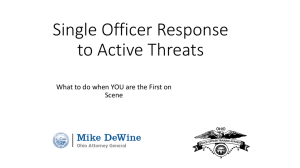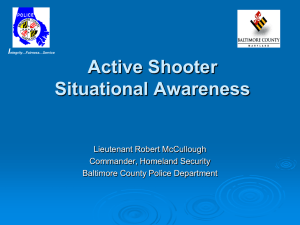Active Shooter presentation
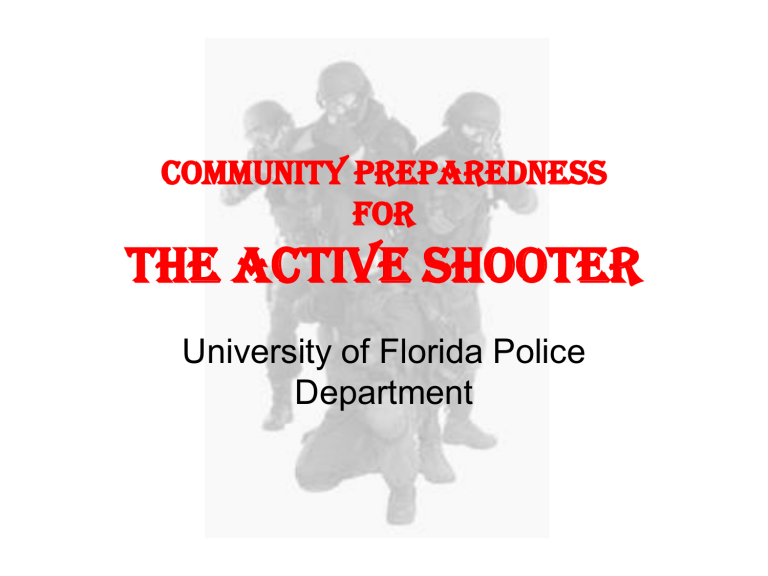
Community Preparedness for
The Active Shooter
University of Florida Police
Department
The Active Shooter Defined
• Any person whose activity is immediately causing death or great bodily harm to the public
• The threat is not contained and there is immediate risk of death and injury
Active Shooter
• Considered the greatest terrorist threat on campuses
• Nationally accepted law enforcement response plans adopted by UF Police
• You need to be informed about law enforcement’s response plans so you can take protective measures
Mentality of Active Shooter
• Desire is to kill and seriously injure without concern for their safety or threat of capture
• Normally has intended victims and will search them out
• Accepts targets of opportunity while searching for or after finding intended victims
• Will continue to move throughout building/area until stopped by law enforcement, suicide or other intervention
The Active Shooter Mentality
(Post Columbine)
• This necessitated a change in tactics by law enforcement
• Losses can be mitigated with community preparedness training and response during actual event
Historical Perspectives
• Spill-over crime – suspect flees onto campus from offcampus incident
• Workplace violence
– Disgruntled employee or estranged husband/boyfriend
– Middle aged Caucasian man
– Poor social skills
– Recent personnel action
– Gun collector, hunter
• Early school shootings
– Student
– Misfit
– Difficulty coping with losses and failures
– Bullied or teased
– Vendetta
Grade Schools vs. UF
• Unlike the middle/high schools, UF facilities do not feature:
– Intercoms in classrooms (Identafone is in 90% of classrooms – similar to intercoms)
– Immediate campus-wide emergency notification system to initiate Campus Lockdown Procedures
– One centralized administrative office
– Visitor access points
– Monitoring and control of students and other people on campus
– Dense campus facility make-up
UF Features
• Strong law enforcement presence and response capability
• Dedicated and concerned community base
• Multiple means for reporting emergencies and alerting the community to an emergency
• Solidly constructed facilities
– Places of refuge
– Multiple escape routes
Your Response
• Your actions will influence others
– Stay calm
– Assure others that you and the police are working to protect them
– The UF Homepage can be accessed for up to date information on the situation.
Your Response
• Secure the immediate area – whether classroom, bathroom, or office.
– Lock the door. This may require advance planning to ensure ability to lock the door – key and type of lock.
– Most doors in the university buildings are solid core, and many walls are block and brick. This may provide some protection.
– Block the door using whatever is available – desks, file cabinets, books, other furniture…
– If the shooter enters your room and leaves, lock/barricade the door behind them.
– If safe allow others to seek refuge with you.
Your Response
• Treat the injured
– Remember basic first aid
– For bleeding apply pressure and elevate
– Be creative in identifying items to use for this purpose – clothing, paper towels, feminine hygiene products, news papers, etc.
Your Response
• Un-securing the area
• The shooter will not stop until his/her objectives have been met, unless engaged by law enforcement
• Consider the risk exposure created by opening the door
• Attempts to rescue people should only be made if that can be done without further endangering the persons inside a secured area
• The shooter may bang on the door and yell for help to entice you to open the door
• Remember the safety of the masses versus the safety of a few
• If there is any doubt to the safety of the individuals inside the room, the area needs to remain secured
Your Response
• Doors, Windows, Openings, and Noise
– Close blinds
– Block windows
– Turn off radios and computer monitors if necessary
– Silence cell phones
– Signs can be placed in the interior doors, windows, but remember the shooter can see these
– Place signs in the exterior windows to identify the location of injured persons
– Keep occupants calm and quiet
– After securing the room; people should be positioned out of sight and behind items that might offer additional protection – walls, desks, file cabinets, etc.
Contacting Emergency Personnel
• 911
• Keep in mind that emergency circuits may be overwhelmed
– Busy signal
– Multiple rings
• 392-1111 for immediate response from the
University Police Department
What to Report
• Your specific location
– Building name
– Office/classroom number
• Number of people at your specific location
• Injuries
– Number of people injured
– Types of injuries
What to Report
• Assailant(s)
– Specific location
– Number of assailants
– Race and gender
– Clothing color and style
– Physical features – height, weight, facial hair, glasses
– Type of weapons (rifle/shotgun, handgun)
– Backpack
– Do you recognize the shooter? What’s their name?
– Have you heard explosions separate from gunshots?
Unsecured Areas
• If you find yourself in an open area, immediately seek protection
• Put something between you and the shooter
• Is escape your best option? Do you know where the shooter is? Is the opportunity of escape immediately available?
• If in doubt, find a safe area and secure it the best way you can
Law Enforcement Response
• Law enforcement will immediately respond to the area.
• It is important for you to convey to others that help is on the way. Remain inside the secure area.
• Law enforcement’s goal is to locate, contain, and stop the shooter.
• The safest place for you to be is inside a secure room.
• The shooter will not flee when law enforcement enters the building, instead the shooter will have new targets to shoot.
• Remember the shooter’s mindset is not escape. Their goal is to kill and injure.
• If law enforcement has to make entry into your room lay flat on the ground with your hands visible. Do what the police tell you to immediately.
Law Enforcement Response
• Injured persons
– Initial responding officers will not treat the injured or begin evacuation until the threat has been neutralized
– You may need to explain this to others in an attempt to calm them
– Once the shooter is contained, officers will begin treatment and evacuation
• Evacuation
– Safety corridors will be established. This may be time consuming
– Remain in secured areas until instructed otherwise
– You may be instructed to keep your hands on your head
– You may be searched
– You will be escorted out of the building by law enforcement personnel
The Investigation
• Information will be released to UF community and media as quickly as possible
• The entire area will be treated as a crime scene
• Once you have been evacuated you will not be permitted to retrieve items or access the crime scene
• After evacuation you will be taken to a holding area for medical care, interviewing, counseling, etc.
Summary
• Active shooter
• You should take a leadership role
• Seek secure area
• Calm, reassure, and quiet others
• Report the incident
• Treat injured
• Law enforcement response
– Objective is to neutralize threat
– Evacuation
– Follow up medical care, interview, counseling
– Investigation
Closing Statement
• We can no longer predict the origin of the next threat
• Assailants in some recent incidents across the country were not students or employees
• There were no obvious specific targets and the victims were unaware they were targets, until attacked
Thank You for Your Attention
Captain Jeff Holcomb
Community Services Division
University of Florida Police Department
P.O. Box 112150 Gainesville, FL. 32611
392-1409 jholcomb@ufl.edu
